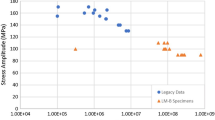Abstract
The mechanisms of low-cycle, fatigue crack nucleation and early growth were investigated at room temperature for Ti-17 (an α+ β titanium alloy). The investigation includedβ processed, high temperature α+ β processed, and low temperaturea + β processed material. The mechanisms of crack nucleation and the path of early crack growth were found to vary with microstructure. Low temperature α+ β processed material demonstrated later crack nucleation but more rapid early crack growth than the other two thermomechanically processed forms. High temperature α+ β processed material containing microstructural flaws, commonly referred to as β-flecks, showed a degradation of fatigue life at high cyclic strain ranges. Results are discussed in terms of microstructural sites of plastic strain concentration.
Similar content being viewed by others
References
L. F. Coffin, Jr.:Annual Review of Materials Science, 1972, vol. 2, pp. 313–48.
M. F. Henry: General Electric Corporate Research & Development Report 71-C-338, 1971.
C. E. Feltner and P. Beardmore:Achievement of High Fatigue Resistance in Metals and Alloys, pp. 77-112, ASTM STP 467,1969.
J. C. Grosskreutz:Phys. Status. Solidi. (B), 1971, vol. 47, pp. 359–96.
J. C. Grosskreutz:Metal Fatigue Damage, pp. 5-60, ASTM STP 495,1971.
C. Laird and D. J. Duquette:Corrosion Fatigue: Chemistry, Mechanics, and Microstructure, pp. 88-117.NACE, 1972.
M. F. Henry: General Electric Corporate Research and Development Report 72CRD100, 1973.
J. B. Newkirk and A. H. Geisler:Acta Met., 19fx Page no.1167, vol. 1, pp. 370-74.
H. Conrad, M. Doner, and B. deMeester:Titanium Science and Technology, vol. 2, pp. 969–1005, Plenum Press, 1973.
D. A. Koss and J. C. Chesnutt:Titanium Science and Technology, vol. 2, pp. 1109–18, Plenum Press, 1973.
N. E. Paton and J. C. Williams: ONR Report Number SC518-20AR, January, 1974.
C. G. Rhodes and J. C. Williams:Met. Trans. A, 1975, vol. 6A, pp. 1670–71.
C. G. Rhodes and J. C. Williams:Met. Trans. A, 1975, vol. 6A, pp. 2103–14.
R. C. Boettner, A. J. M Evily, Jr., and Y. C. Liu:Phil. Mag, 1964, vol. 10, pp. 95–106.
C. A. Stubbington, A. W. Bowen:J. Mater. Sci., 1974, vol. 9, pp. 941–47.
C. H. Wells and C. D. Sullivan:Trans. ASM, 1969, vol. 62, pp. 263–70.
D. K. Benson, J. C. Grosskreutz, and C. G. Shaw:Met. Trans., 1972, vol. 3, pp. 1239–48.
R. B. Sparks and J. R. Long: Technical Report AFML-TR-73-301, Feb. 1974.
Author information
Authors and Affiliations
Additional information
Formerly a member of the Research Technology Program, General Electric Research and Development Center
Rights and permissions
About this article
Cite this article
Funkenbusch, A.W., Coffin, L.F. Low-Cycle fatigue crack nucleation and early growth in Ti-17. Metall Trans A 9, 1159–1167 (1978). https://doi.org/10.1007/BF02652221
Received:
Issue Date:
DOI: https://doi.org/10.1007/BF02652221




